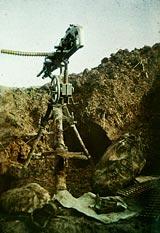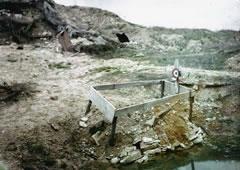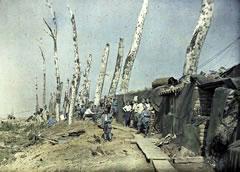Captured in colour: rare photographs from the First World War - The reality of trench warfare
By the end of 1914, it was clear that the war would not end quickly. The days of bright uniforms and dashing cavalry charges were gone. The power of new technology – better rifles, machine guns, more powerful artillery – forced the war into stalemate on both sides.
The realities of trench warfare on the Western Front presented the autochromists with a number of challenges. Empty fields of mud and a demoralising stalemate did not lend themselves to the picturesque beauty of the travelogues they were used to. However, in time Castelnau and Gimpel’s images would turn much that characterised the war experience – the machine-gun, the heavy technology, the mud, the dispassionate formal pose for the camera, the battlefield grave – into lasting symbols.

Jean-Baptiste Tournassoud
French soldiers in trench, c. 1916
print from autochrome
Établissement Cinématographique et Photographique des Armées
AUL 96

Léon Gimpel
French machine-gun in trench, Carency, 1915
print from autochrome
Société Française de Photographie
SFP 806/271-A

Paul Castelnau
French 370-millimetre railway gun, 1917
print from autochrome
Archives Photographiques, Ministère de Culture
CA 000650

Jean-Baptiste Tournassoud
French gravesite
print from autochrome
Établissement Cinématographique et Photographique des Armées
AUL 59

Paul Castelnau
French front lines, Boesinghe, 1917
print from autochrome
Archives Photographiques, Ministère de Culture
CA 000694

Paul Castelnau
French front lines, Boesinghe, 1917
print from autochrome
Archives Photographiques, Ministère de Culture
CA 000695